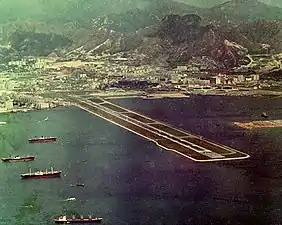Thai Airways International Flight 601
Thai Airways International Flight 601 was a Sud Aviation Caravelle that crashed into the sea on landing at the former Kai Tak Airport, Hong Kong, in a typhoon on Friday, 30 June 1967.
_at_Stockholm-Arlanda_Airport.jpg.webp) A Thai Airways International SUD-Aviation Caravelle similar to the one involved. | |
| Accident | |
|---|---|
| Date | 30 June 1967 |
| Summary | Landing accident |
| Site | near Kai Tak Airport, Hong Kong 22°18′07″N 114°13′02″E |
| Aircraft | |
| Aircraft type | Sud Aviation Caravelle III |
| Aircraft name | Chiraprapa |
| Operator | Thai Airways International |
| Registration | HS-TGI |
| Flight origin | Haneda Airport, Japan |
| 1st stopover | Songshan Airport, Taiwan |
| Last stopover | Kai Tak Airport, Hong Kong |
| Destination | Don Mueang Airport, Thailand |
| Occupants | 80 |
| Passengers | 73 |
| Crew | 7 |
| Fatalities | 24 |
| Injuries | 56 |
| Survivors | 56 |
Accident
Thai Airways International Flight 601 took off from Taipei Songshan Airport (TSA/RCSS) on an hour-long flight to Kai Tak Airport. The Sud Aviation Caravelle (Registration: HS-TGI), which had made its first flight in 1960, had 80 people aboard: 73 passengers and 7 crew. With the plane on ILS approach to runway 31 at Kai Tak (HKG/VHHH), the Captain became occupied trying to make visual contact with the ground, and failed to notice that the aircraft had descended below the decision height of 415 feet (126 m). The crew made an abrupt heading change (while already 80 feet (24 m) below the glide slope), and then entered a high-speed descent. The aircraft undershot runway 31 and crashed into the sea, killing 24 passengers.

Probable cause
The probable cause of the accident was pilot error, specifically not noticing that the aircraft had descended below the glide slope. The presence of strong wind shear and downdrafts as a result of then-present Typhoon Anita was a probable contributing factor. However, at the time of the accident there were no means of detecting such weather phenomena. Further factors included:
- The pilots did not adhere to Thai Airways procedure for a captain-monitored Instrument approach in bad visibility.
- The captain did not monitor the approach adequately.
- The abrupt heading change after the aircraft descended below minimum altitude may have exacerbated the high rate of descent.
- Downdrafts and wind shear may have contributed to the height loss which resulted from this mishandling.
References
- Accident description for HS-TGI at the Aviation Safety Network. Retrieved on 12 July 2013.